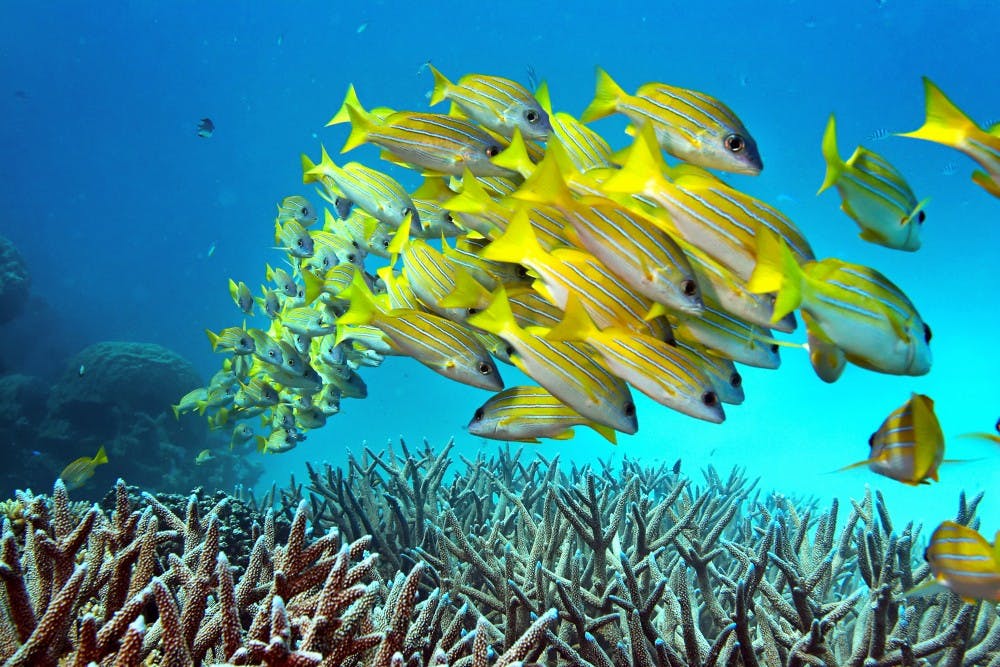Clickbait titles and eye-catching headlines are often used by modern journalists for the purpose of drawing immediate attention to their work. The strategy results in a large number of views, but what we're failing to realize is that imprecise headlines misinform our often non-reading audience.
On Oct. 11, an article titled “Obituary: Great Barrier Reef (25 Million BC-2016)” was posted by Outside and spread rapidly through social media. The post has been shared over 1.42 million times. Most people didn’t bother to read past the title and assumed the Australian reef was ruined.
The Great Barrier reef has officially died https://t.co/Ikn5DBmpGn
— The Independent (@Independent) October 15, 2016
The "news" caused immediate outrage among readers. The idea that something so beautiful, a worldwonder even, had died was both astonishing and disappointing.
However, if people had taken a moment to research the situation at all, they'd know the Great Barrier Reef isn’t dead. In fact, the author, Rowan Jacobsen, is not a scientist, either, he's an environmental writer.
93 percent of the reef is affected by bleaching, which is a process through which symbiotic algae causes the reef to turn white due to stressors. This does mean that the reef is in danger of extinction, but it's definitely not gone yet. Unfortunately, the author of the article may have unknowingly deterred people from taking action to save it because they thought it was destroyed.
We can still save the Great Barrier Reef. Please share this ♻️ pic.twitter.com/txv5fywFmH
— Gabrielle Webb (@gabswebb) October 15, 2016
Chief of the Coral Reef Ecosystem Program at NOAA’s Pacific Island Fisheries Science Center Russell Brainard said he believes the article was highlighting the urgency of the situation, but that those who don’t have any context “are going to take it at face value that the Great Barrier Reef is dead,” according to the Huffington Post.
This type of journalism has bred an audience that's unable to distinguish satire or clickbait from actual news. Every week I see people on Facebook sharing articles from The Onion and expressing actual anger or disagreement, not realizing the source is a satirical publication.
Social media has played a huge role in the circulation and popularity of clickbait. Publications base their worth on how many shares they get, and not necessarily the quality of their content. When a writer's purpose is to go "viral," they lose the journalistic value of their work.
Milton Coleman, Edith Kinney Gaylord visiting professor in journalism ethics, said the purpose of a headline is to be an accurate summary of a story. He believes that if a journalist can’t attract an audience with the facts, they shouldn’t write the story at all.
“It’s (headline) the effective title of the story, and you want the title to be accurate," Coleman said. "Some words are “sexier” than others, they draw more readers in. But I try to tell my students that what we are doing is not providing content, we’re doing journalism.”
Coleman said you lose credibility as a journalist by misleading an audience and stretching basic ethical principles is bad journalism.
“What kind of journalist are you? How far will you stretch the basic principles?" Coleman said. "The basic principle is the headline should be an accurate reflection of the story.”
We as journalists have to realize that more often than not, a reader gets through the first few paragraphs before they move on to the next story. If you don’t establish early on that your headline is true or false, you risk someone sharing the article or spreading word by mouth in a way that falsely depicts what you're writing about.
Many sectors of journalism are failing at this — on YouTube, creators use jaw-dropping titles to make people click. On E! News, anchors hint at scandals only to reveal later in the show that it was a false rumor they’re dispelling. On Outsideonline.com, they insinuate one of the world's largest and most diverse aquatic reefs has died out to do human error, creating panic and alarm.
However, this isn't just happening in the headlines. Many writers choose cover photos for their articles that are violent or sexual in order to attract more readers. It's sensationalism at its core.
This unethical form of reporting has to end. Modern journalists are too focused on entertaining an audience, and not focused enough on informing them. We'd rather raise our readers' hopes only to let them down, than to not attract them at all. Our job is to spread truth, and this toes the line. We're pushing the public farther and farther away, and wondering why they don't trust us.
Spreading news isn't about flashiness or catching the eye. In this case, the ends do not justify the means. Those extra view counts will never be worth the lessening of your publication's credibility or reputation.
Reach the columnist at sphaas@asu.edu or follow @_SavannahHaas on Twitter.
Like The State Press on Facebook and follow @statepress on Twitter.
Editor’s note: The opinions presented in this column are the author’s and do not imply any endorsement from The State Press or its editors.
Want to join the conversation? Send an email to opiniondesk.statepress@gmail.com. Keep letters under 300 words and be sure to include your university affiliation. Anonymity will not be granted.




